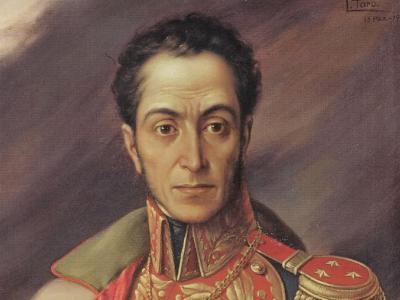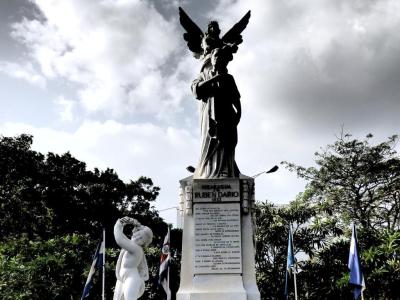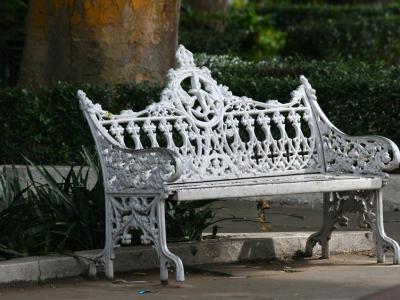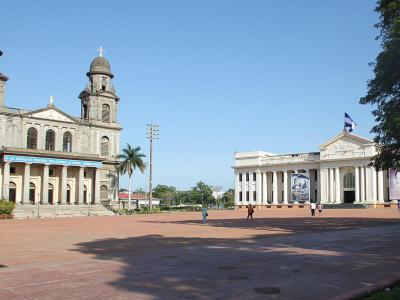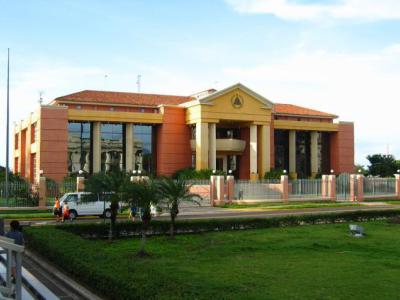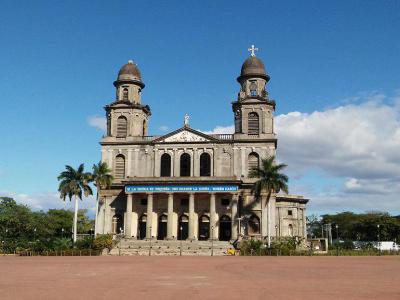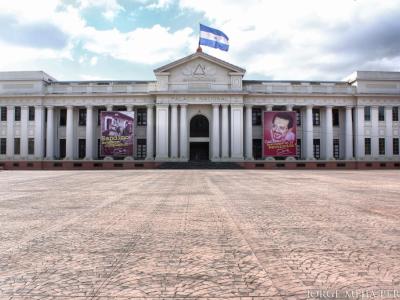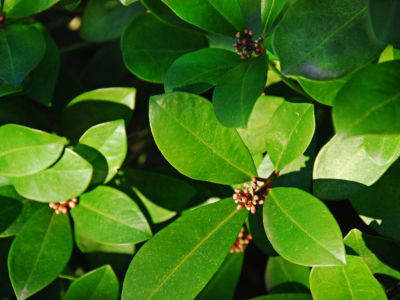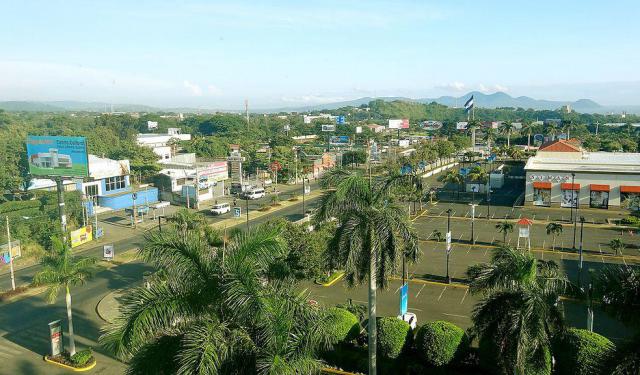
Managua Introduction Walking Tour (Self Guided), Managua
Managua is one of the most beautiful cities in Nicaragua. It has many places to visit, such as parks, monuments, promenades, old buildings and beautiful avenues. There are historic attractions that have great importance for the city and nation. Take the following tour to discover this unique area and see its great attractions!
How it works: Download the app "GPSmyCity: Walks in 1K+ Cities" from Apple App Store or Google Play Store to your mobile phone or tablet. The app turns your mobile device into a personal tour guide and its built-in GPS navigation functions guide you from one tour stop to next. The app works offline, so no data plan is needed when traveling abroad.
Managua Introduction Walking Tour Map
Guide Name: Managua Introduction Walking Tour
Guide Location: Nicaragua » Managua (See other walking tours in Managua)
Guide Type: Self-guided Walking Tour (Sightseeing)
# of Attractions: 10
Tour Duration: 2 Hour(s)
Travel Distance: 2.2 Km or 1.4 Miles
Author: jenny
Sight(s) Featured in This Guide:
Guide Location: Nicaragua » Managua (See other walking tours in Managua)
Guide Type: Self-guided Walking Tour (Sightseeing)
# of Attractions: 10
Tour Duration: 2 Hour(s)
Travel Distance: 2.2 Km or 1.4 Miles
Author: jenny
Sight(s) Featured in This Guide:
- Plaza de la Fe Juan Pablo II (John Paul II Faith Plaza)
- Monumento a Simon Bolivar (Monument to Simon Bolivar)
- Ruben Dario National Theater
- Monumento Ruben Dario (Ruben Dario Monument)
- Parque Central (Central Park)
- Plaza de la Revolucion (Revolution Square)
- Casa Presidencial (Presidential Palace)
- Antigua Catedral de Managua (Old Cathedral of Managua)
- National Palace of Culture
- Arboretum Nacional (National Arboretum)
1) Plaza de la Fe Juan Pablo II (John Paul II Faith Plaza) (must see)
In the center of this large plaza, you will see a tall obelisk and four plaques, each of which commemorates the visit of the Pope John Paul II in 1983. The day of his visit was declared a holiday, during which different cultural and religious events took place to commemorate this important event. Since that day this plaza has been an important cultural point in the city and a spot popular with tourists.
2) Monumento a Simon Bolivar (Monument to Simon Bolivar)
The statue of Simon Bolivar is located in an area of the city known for its monuments. The figure represents one of the most important personalities from Venezuela. Though not a Nicaraguan, he was one of the most important leaders of Spanish American’s struggle for independence from Spain. Due to his contribution to the freedom of Nicaragua along with other states as Venezuela, Panama, Peru, Colombia and Bolivia he deserved a statue to commemorate him.
3) Ruben Dario National Theater
Ruben Dario National Theatre is the most well-known and important theatre in Managua and all of Nicaragua. The building survived even the earthquake in 1972 when almost the entire city was destroyed. The theatre is known as a modern one where famous artists, both local and foreign, perform shows and concerts. In addition, different exhibitions, conferences and other cultural events are hosted here. The theatre is named in honor of the most famous Nicaragua poet, Rubén Dario, known for his movement called modernismo from the end of the 19th century. Besides a poet, Dario was a diplomat and leading voice of Central America that represented its rights.
4) Monumento Ruben Dario (Ruben Dario Monument) (must see)
The monument of Ruben Dario is located in the park near the Plaza de le Revolución. The monument commemorates the famous poet, a leader of the modernism movement that characterizes Latin America literature. He was also one of the best representatives of Central America to the world because during his lifetime he was also an ambassador. The monument has a modern style.
5) Parque Central (Central Park)
The Central Park of Managua is a great spot to visit, near some well-known and important buildings that when combined with the park makes this the most attractive part of the city. The park was created in 1899 and due to its form and style it belongs to the neoclassical style. The name was given in honor of Mayor S. Fonseca Estrada, who named the park General Park, dedicated to the general efforts of his work, but local people called the park central and this name has remained to today. It lost its initial style in the earthquake in 1931, but it was restored and now has a new image. Monuments of local and national figures are located in the park.
6) Plaza de la Revolucion (Revolution Square)
Plaza de la Revolucion is the historical center of the city. It was also named Plaza of the Republic. It suffered great damages in the earthquake of 1972 but it was not restored completely, so some initial elements of the plaza remain. The plaza covers some of the most important attractions of the history of the city: Old Cathedral; Central Park with monuments of important personalities; Ruben Dario National Theatre; and National Palace of Culture.
7) Casa Presidencial (Presidential Palace) (must see)
Casa Presidencial is the main office of Nicaragua's president. The Casa Presidencial was opened in 1931 during the presidency of Jose Maria Moncada. Three months later it was partially damaged in an earthquake. In 1934 the Casa Presidencial was restored by General Anastasio Somoza García. It was also used as a house for his sons who were also presidents. In 1972 the building was damaged again due to a powerful earthquake. It was restored and now the current president of Nicaragua, Daniel Ortega, lives here. Ortega is known as the leader of the Sandinista National Liberation Front.
8) Antigua Catedral de Managua (Old Cathedral of Managua) (must see)
The Old Cathedral of Managua, known as the Catedral de Santiago in Spanish was designed in, and shipped from Belgium in 1920 by architect Pablo Dambach. The cathedral survived the 1931 earthquake but was extremely damaged due to the 1972 earthquake and was condemned, which led to the construction of the new cathedral of Managua or "Catedral de la Concepcion", the newest constructed Roman Catholic cathedral. However, in recent years, the restoration of the old cathedral has appeared to be possible and it is currently awaiting its renovation.
Sight description based on Wikipedia.
9) National Palace of Culture (must see)
The National Palace of Culture is one of the buildings that did not receive damage during the earthquake in 1972. It was designed by the architect Pablo Dambach. Earlier, it housed the Congress; now it is a historic place that houses the National Library, the National Archives and the National Museum of Managua. The library contains unique editions of books in which important historic events are related. The archives have a rich stock of documentations, maps, and important documents that relate the historic events of the nation's formation. The museum has a full spectrum of exhibitions with a timeline that starts 500 million years ago. It also houses an exhibition of pottery, pre-Columbian statuary, documents that relate the formation of the lakes and volcanoes, pre-Columbian paintings, statues and ceramics.
10) Arboretum Nacional (National Arboretum)
Arboretum Nacional is a beautiful place dedicated to maintainig and developing the plants' growth along with promoting environmental awareness. It has more than 200 species of plants divided into classes and zones. All these plants form a collection of plants from different regions of the country. Here you can see the national tree called madrino and the national flower called sacuanjoche that both deserve admiration. It is a vibrantly green and splendid place where people can enjoy some time walking and admiring the beauty of nature.
The Most Popular Cities
/ view all

